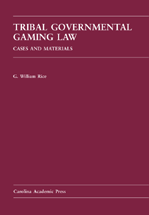Tribal Governmental Gaming Law
Cases and Materials
2007
Tags: Indian and Indigenous Peoples Law
880 pp $94.00
ISBN 978-1-59460-208-5
Tribal Governmental Gaming Law: Cases and Materials is a law school casebook and compilation of primary source materials setting out the federal laws which regulate gaming conducted by various Indian tribal governments. The casebook includes the National Indian Gaming Regulatory Act, the Committee Report, and attorney opinions from the Office of General Counsel of the National Indian Gaming Commission. Beginning with the early case law which led to the development of the Indian gaming industry, major sections of the work address such issues as Gaming Management Contracts, the distinctions between Class II and Class III gaming, Tribal-State gaming compacts, the acquisition of land for tribal gaming facilities, and various other issues related to the Indian gaming industry. The text contains or refers to virtually every significant Indian gaming law case from the United States Courts of Appeals and the Supreme Court. The cases are carefully edited and arranged by the issues litigated and, when relevant, by circuit.
Students of Indian gaming law who have not taken the introductory course in Indian law, and practitioners without a background in Federal Indian Law will appreciate the introductory material which takes the form of a "conceptual glossary" providing working definitions of some Indian law terms which are important to understanding the issues which relate to gaming by Indian tribal governments. For those with an adequate background in the core concepts of Federal Indian Law, this material will provide a useful review, and perhaps provoke discussion of the basic assumptions upon which the law is based.
The edited cases, combined with the primary legislative and administrative materials, the introductory material, and provocative notes, make this an excellent teaching tool for students and faculty, and a reference book which should remain useful for many years to those involved in the Indian gaming industry.


